Braham Devata
Life of Sant Shri Trikmacharya Maharaj
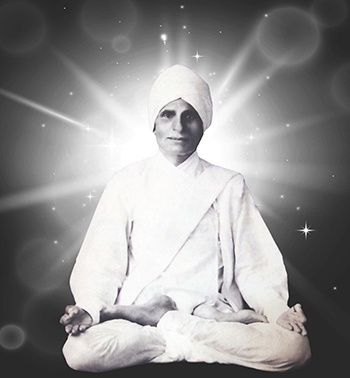
- Acknowledgements
- Introduction
- Insight
- For the Next Generation
- Bardai Brahmins & Geography
- Braham Devata: The Life of Sant Shri Trikmacharya Mahraj
- A Rishi is Born
- Where has young Trikamji gone?
- Marriage
- Bhabhi’s Curse
- Miracle in Rojhda Gaam
- In search of the Guru
- Sadhna at Girnar
- Aabhapro Doongar
- Darshan
- Gnan Prakash
- Meditation in Dwarka
- Natwar Gaam & Bardai Brahmins
- His Parcha (Miracles)
- Adityana Gaam & His Departure
- Miracles After His Departure
- Closing Message
- Copyrights
Acknowledgements
This divinely inspired work would not have been possible without the kind support from the numerous well-wishers around me. Where such work is conducted, mention of persons and helpers by name is generally not necessary or warranted, for it is the duty of every individual to preserve and pass on his heritage as well as maintain his roots and identity.
Having said this, I do not want to miss this opportunity to thank and acknowledge the following individuals without whose assistance this small piece of work would not have been wholly possible.
In particular, special thanks and appreciation to:
Shri Tribhovandas Damodarbhai Joshi for assisting in the Gujarati translations. It’s been a great journey and a time spent which I will cherish forever!
Shri Ashwin Amratlalbhai Modha for his kind permission and unreserved use of colour paintings depicting Shri Trikamji Bapu’s life. These have brought life to the writings and I am sure will make the reading experience much more enjoyable.
Introduction
Every being has an internal desire to realise the Creator. Whether an individual has become aware of this yearning or not is a different matter. After many births this programmed need becomes realised and the individual awakens to the call of the Supreme. There then arises an unquenchable thirst, which leads to the treading of a fiery path. The end result being the evolution of a divine individual whose life touches many, even after His physical disappearance.
Yogi Sant Shri Trikmacharya Maharaj was one such divine soul.
Although born 151 years ago (2014), not much is really known about this mysterious saint and we have to rely heavily on stories, which have been handed down over the generations. A few individuals who met “Bapu (father) are still alive, but they were young at the time and as a result we only have very small glimpses into His life and activities.
The following is a humble attempt to present the life story and miracles of Pujya Shri Trikamji Bapu. The information contained herein has been collected from various Gujarati literature, conversations with elders in the community and pilgrimages to the various places Bapu is said to have visited. This effort has been made in order to preserve His green memory as well as highlight the effects He had on the social culture at that time for all Bardai Brahmins.
More importantly, we must not lose sight of the fact that through His yogic practices, Bapu demonstrated how an “ordinary (Bardai) man” rises himself above this material world and attunes to the Supreme realm through perseverance and regular “sadhna” (spiritual practice).
I hope the reading of this small piece of work inspires the reader towards this eternal and divine goal.
Written as a humble servant and in prostration to the Supreme Creator!
Jai Shri Trikmacharya Maharaj!
Insight
Currently, and as far as is known, there only exist two close up photos of Shri Trikamji Bapu and one possible original portrait painting. There are two other photos, which exist as group photos, but these are not as clear or as defining.
If you look at any of the two original photos of Shri Trikamji Bapu, the vitality and composure in His appearance is unmissable!
Observing both pictures closely, a unique insight can be had and this is in particular to the pose, dress and place where the photos were taken.
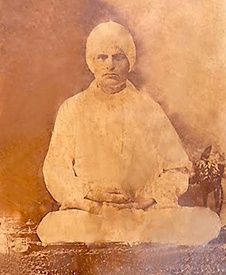
Photo: Beroja, Gujarat
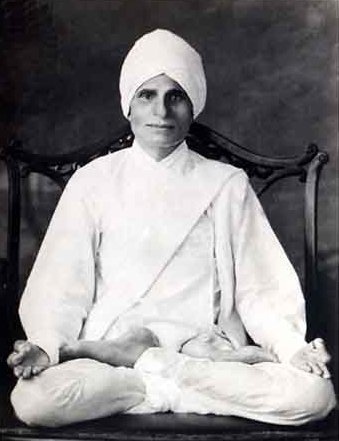
Photo: Mumbai, Maharashtra

Photo: Mumbai, Maharashtra – Full Picture
The first photo was taken in the town of Beraja and the very “otlo” (platform) where Bapu is sitting can still be found at the family home of the Modi family. This is obviously a more youthful and earlier photo, but what is evident are the yogic pose and hand mudra (“Padmasana” or full lotus position with hands in Dhyani pose) and the ease with which He seems to have adopted to this seating.
The second photo was taken in a studio in Mumbai. Once again Bapu is seen in the classic Padmasana pose but this time with hands holding the Jnana or Chin mudra.
What is interesting in both pictures is the dress and “paghdi” (turban), which do not seem to match the classic Gujarati style of clothing.
it has now come to light that Bapu’s dress was more than likely adopted from His stay in Anand Ashram, Bilkha, where He met His first guru, Paramhansa Pujya Shri Nathuram Sharma.
The resemblance in dress is evident and undoubtedly very similar.

The image below is of an oil painting of Bapu said to have been be done during His stay in the gaam of Balva, Gujarat. Although the original has been seen, it bears great resemblance to the black and white photo taken at Beraja and thus the “originality of this painting being a live canvas cannot be confirmed.

Two other rare photos of Bapu have been found and although these are of very poor quality, they do give the reader a small glimpse into an era that has very much disappeared. 0
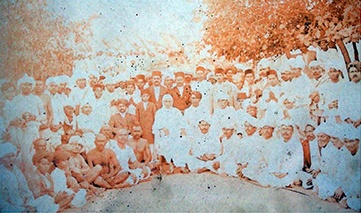
Photo: Baworvav, Gujarat

Photo: Kunwadar, Gujarat
What the latter two photos do reveal and confirm is that during His normal stay and day-to-day activities, Bapu wrapped Himself with only one long piece of white cloth. This is distinct from regular photos we see where He is seen wearing a “dhoti, jabo and paghdi”.
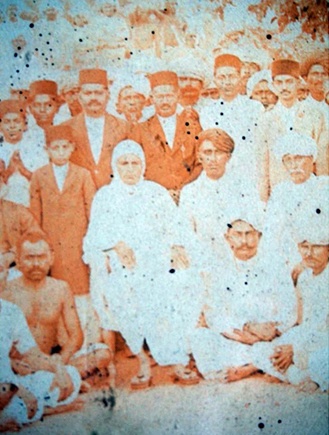
Also worth noting, are the “Chakri” (wooden sandals) and these can be regularly seen as “Guru Paduka” (Guru’s sandals) which are worshipped at the various “asans” (place/seat) that Bapu visited.
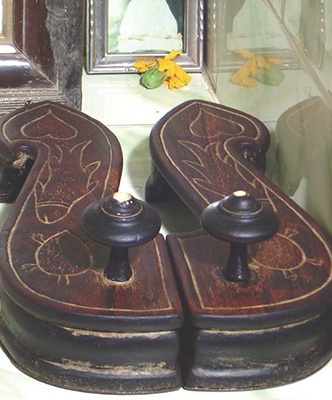
For the Next Generation
It is regretful and sad to say that today; Bardai communities both in India and abroad are becoming less familiar with the life story of Pujya Shri Trikamji Bapu and His great significance. Whether this is through seer ignorance and limit of knowledge or just non-belief and lack of interest is a matter for personal contemplation. Without doubt, there are still a handful devotees that revere and continue to recognise Bapu with the greatness that He deserves.
In transforming His life and becoming a topmost yogi, Shri Trikamji Bapu changed the future path for all Bardai Brahmins. In taking such actions, He paved a way, which has led to the prosperity that our community enjoys today. It is worth taking the opportunity to summarise His spiritual as well as His social significance and recall the appeal He has made to the Bardai community:
- Displayed numerous “parcha” (miracles), which gave faith to the ordinary people in the existence of the greater Supreme Lord.
- Provided Bardai Brahmins with an identity and presence that distinguishes us from the other Brahmin communities (“moti nath”), viz: Awdich and Nagar Brahmins but to name a few who also inhabit the same area of Porbandar and neighbouring towns around the Barda range of mountains.
- Stopped the practice and custom of “selling” young Bardai girls (“Kanyia Vikrai”) by parents who would only exchange the bride’s hand in marriage for return of a very large dowry.
- Blessed the community (who were at that time mainly labouring farmers) that they would prosper if they carried out the above practice. It led to the modern day custom of parents being reluctant to accept anything from their married daughter’s household (including food) and if anything is accepted, it is always paid back in one form or another.
- Requested that widows not re-marry. Although this practice may appear controversial today, the reasoning behind why Bapu instructed this is at that time is not fully known or understood.
The duty now falls on the current generation to preserve and maintain this part of our Bardai identity and heritage. In this respect, an echoing call goes out to all Bardai Brahmins to spread and keep alive the name of our beloved Bapu and Guru, Sant Shri Trikmacharya Mahraj.
All we have to do is have the conviction that through His divine grace and blessings, our Bardai community will once again flourish and re-establish itself in its true Brahmanical roots. By doing so, let our Bardai Brahmin Samaj become re-established and transform into a beacon example that all other fellow communities aspire to and follow.
Jai Shri Trikmacharya Mahraj!
Bhavesh Tribhovandas Joshi
“Out of many thousands among men, one may endeavor for perfection, and of those who have achieved perfection, hardly one knows Me in truth.” – Bhagavat Gita: Ch. 7.3
Bardai Brahmins & Geography
We are the descendants of a bloodline of Brahmins that settled near the Barda range of mountains on the outskirts of Porbandar, Gujarat. With time we have become associated with this mountainous range and have adopted the name Bardai Brahmins to denote our heritage.
The map below shows some of the main towns associated with our community as well as areas where Shri Trikamji Bapu lived and visited.
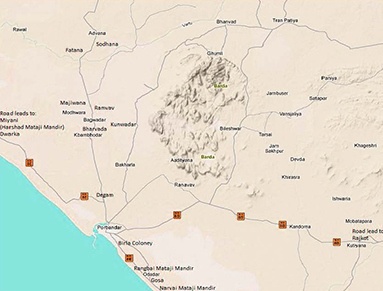
Gujarat Coastline showing Porbandar, Gaams & Barda range of mountains
Some towns relevant to Bardai Brahmins and located on the above map are:
Aadityana Advana Bagwadar Bhanvad Fatana Ghumli Gosa Kunwadar Majiwana Porbandar Ranavav Sodhana Rozda
The Bardo range of mountains stands in the backdrop near Porbandar, with “Aabhapro” doongar (mountain), as one of the highest peaks (1938 ft.) and shades the temple of Ashapura Mata below.

Peak of Aabhapro & Bapu’s Mandir
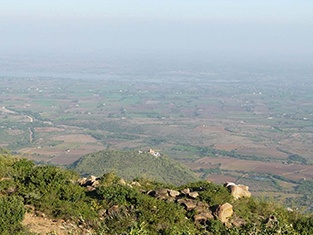
View of Ashapura Mandir, half way up Aabhapro Doongar
Braham Devata: The Life of Sant Shri Trikmacharya Mahraj
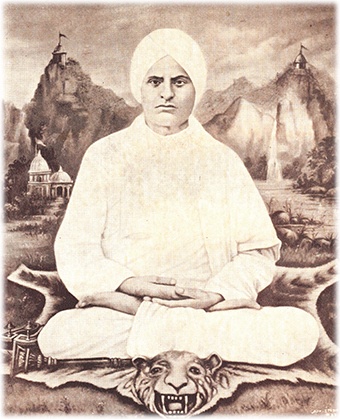
Vikram Savant: Paush Sudh Satam 1920 – Mahavad Teras (Shivratri) 1986
Georgian Calendar: 15th January 1864 – 26th February 1930
OM Satchidanand Prabhu param kripalu parmeshwar tame din dayalu Vishvambhar OM OM OM
OM. Oh Supreme Lord who is Truth, Consciousness and Bliss thou art forever benevolent and compassionate. OM OM OM.
This was the mantra given to our Bardai community by Sant Shri Trikamji Bapu.
“A Rishi is Born”
Pujya Shri Trikamji Bapu was born in 1920 Vikram Savant, in the very early morning on the day of Saatam, Sudh, Paush Mass (15th January 1864 A.D.) in Kunwadar “gaam” (town), Gujarat.
His father’s name was Haridas (Harji) Maharaj and His mother’s name was Laajbai mata. They had one son already and Trikamji was the second who was born to them.
Haridas Maharaj had waited in anticipation on the veranda as the midwife ran out and announced that the family had another son. “Kaka, He looks just like a Rishi!” she exclaimed.
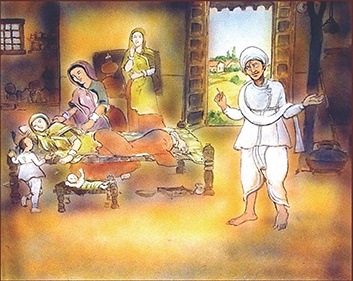
“Wah Trikamji wah!”
On hearing this, Haridas Maharaj dreamt in his mind that his son would one day be the pandit to Rana Sahib (Raja of Porbandar) and that this land would one day bow down to Him. Enveloped in such high thoughts, he entered the room. On seeing his new born son, out of excitement and without thinking Haridas Maharaj exclaimed – “Wah Trikamji wah!” Uttering the name of Shri Dwarkadhish (Lord Shri Krishna), he named his son Trikamji. This given name already had great opulence.
Note: In total there were 7 siblings:
5 brothers (in order):
- Liladharbhai (his son was Jino, who later become known as Jina Bapu)
- Trikamji Bapu
- Odhovjibhai
- Savrajbhai
- Naranjibhai
2 sisters:
- Gangaben
- Gomtiben
An “Ambo” (Family Tree) for Pujya Trikamji Bapu hos recently been commissioned by us and this can now be found on the website as well as at “Bapu ni Voov”, near Bhonvad, Gujarat.

Place of Bapu’s Birth – Kunwadar
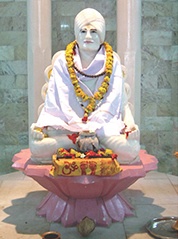
Murti within the mandir at Kunwadar
Young Trikamji was a bright lad and soon He was admitted to the local school, but all He used to do was to write the number “0” on His writing slate. On being questioned as to what He was doing, He would indicate that this whole body and world amounted to the number zero – nothing!
Seeing that his young son was not going to progress academically and not interested in education, Haridas Maharaj eventually got Trikamji to work on the fields.
On one occasion Trikamji was sent to look after the cattle herd. Instead of looking after them, young Trikamji stared at the sky, with mind in turmoil and a constant question arising in His heart – “Who am I?”
On seeing the young lad appearing to daydream, one of the villagers advised Trikamji that His herd of Cows was wondering off. Instead of getting worried, Trikamji replied, “Don’t worry, the herd will return by themselves.”
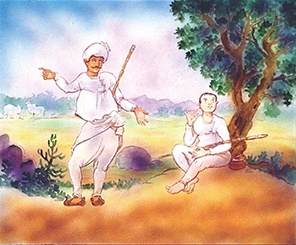
“Who am I?”
Once again the young lad’s eyes fixed onto the horizon and He fell into a trance… listening to a divine voice He became lost in His own world.
The old man, feeling insulted moved along his own journey muttering “…Either the lad will go mad or He’ll run away somewhere. What is the use of daydreaming all the time?”
The oxen had already reached home before the man did, so there was really no need to complain but feeling disrespected, he repeated the incident to Haridas Maharaj.
Hearing this story fuelled Haridas Maharaj’s anger as the man continued talking, “Kaka, your Trikamji was sitting staring at the sky. I tried to awaken Him, but all He did was talk to me about miracles and magic like a big man!”
As dusk drew near, Haridas Maharaj paced up and down thinking of a severe punishment for his young son. As the herd of cattle approached the outskirts of the village, he saw young Trikamji walking slowly, lost in His own thoughts. Just like Gopal Krishna, his son had a purposeful look about Him. Nobody would dare to look into His eyes and there was no question of punishing Him!
With a stick in his hand and ready to deliver a harsh punishment, Haridas Maharaj stood waiting in the Veranda.
“Trikamji!” shouted Haridas Maharaj as the young lad entered. As if nothing had happened, young Trikamji put down His staff (cattle prod) and went inside, washed up and returned to the veranda.
Haridas Maharaj became enraged, but as young Trikamji turned and looked at His father, he saw that his son’s eyes were full of innocence. If someone hadn’t called him, Haridas Maharaj would have continued his angry words. Call it divine intervention or whatever, but whenever he tried to punish young Trikamji, he would always become distracted. However, the truth of the matter was that deep inside, Haridas Maharaj did not have the heart to chastise his beloved son. He knew that Trikamji was no ordinary individual and that some misfortune in His past life had brought Him into this material world. He was not a burden to this world, but, on the contrary, the world was a burden on to Him. These types of thoughts often arose in the mind of Haridas Maharaj.
During all this, young Trikamji just sat there… with His eyes shut and in divine contemplation He remained still like a silent sadhu!
As Trikamji grew older, He remained totally disinterested in the joys of materialistic life and as such tried to distance Himself from it, always remaining in deep contemplation and thought.
Additional Stories:
One story retold was that at the age of 13 years, young Trikamji visited Aabhapro Doongar (hill) in the Barda range of mountains. Here, He met a sadhu who gave Him a green covered book. Although uneducated, it is said that young Trikamji was able to read and understand the contents of that book.
Another story gives us the glimpse of His bravery, when young Trikamji stood up to raiding bandits who had invaded Kunwadar gaam. It is said that while everyone else had run inside to hide, a young Bapu confronted the invaders telling them that they were committing a big sin and going against Hindu “dharma” (correct conduct).
“Where has young Trikamji gone?”
On one occasion and by chance, Haridas Maharaj uttered the words, “Go leave this place.” The following day, Trikamji was nowhere to be found. Being remorseful, Haridas Maharaj sent search parties to Porbandar and the adjacent villages, but Trikamji could not be found anywhere.
Even the traders who were returning after several days from the surrounding towns brought no news of young Trikamji. It became evident that He was not residing in any of the nearby towns or villages.
Laajbai mata, overwhelmed with grief, thought that it would have been better to marry her son off at an early age so that He would never have contemplated on leaving.
As time passed all the people of the village began talking. As if with one voice, it was said that Trikamji had become a “Sadhu”. Otherwise why would He leave without saying anything and for no reason?
Some villagers from Kunwadar had gone on a yatra (pilgrimage). It so happened that 2-3 months later, post arrived with letters containing news about their journey. One such letter contained the following message:
“We are all having a good time visiting temples, bothing in the river Yomuno, worshipping and enjoying the delicious prashod. Along the way we are giving alms and money to charity… Oh, by the woy, Trikamji is with us, so do not worry.”
Like a wandering nomad, Trikamji had the inner desire to visit all the said holy and divine places, but being totally uneducated did not have the means to enlighten those visiting just on blind faith.
Trikamji belonged to no sampradaya (lineage), but knew only the One true God. Even with the thousand names of the Almighty, His personal God had no name. To Him, God was God and even when the pilgrims obeyed
the instructions of the local priests, Trikamji stood alone and set Himself aside from the rest of the group.
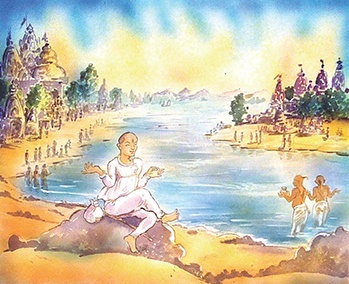
Young Trikamji only found false pilgrims and pundits at places of pilgrimage
In His mind, Trikamji had one disturbance and that was that He had not told his family members about His departure. Also, the peace that He thought he would gain by visiting the holy places was not materialising and slowly He was becoming disheartened.
At the various “Tirths” (holy places), Trikamji noticed the overweight “pujaris” (priests) with protruding stomachs and how they fooled the arriving pilgrims with lies and dishonesty. Not only that, but that these “holy” places had become an attraction where ordinary people were easily being conned.
On witnessing all these actions and falsehood, Trikamji now desired to return back home. On several occasions, He thought of writing a letter to His father to ask to fetch Him, but to maintain His firmness, refrained from doing this. However, should even a child from Kunwadar have come to collect Him, He would have happily gone back.
The news of hearing that Trikamji was travelling with pilgrims gave great relief to Haridas Maharaj. Knowing that his son had not become a sadhu or joined any sect, he instructed his older son, Liladhar, to go and fetch Trikamji and bring him back home.
His older brother, Liladhar, had been given strict instructions by Haridas Maharaj that under no circumstances was he to shout at his younger brother, but to bring Him home peacefully and quietly.
But, when the time came to convince Him, Liladhar found no difficulties and young Trikamji followed the request of His older brother. Without any hesitation, they both made their way back to Kunwadar gaam and home.
“Marriage”
On returning home, Laajbai mata’s desire was fulfilled and Trikamji was married to Benbai, a young girl from a Modha household of Rojhda gaam.
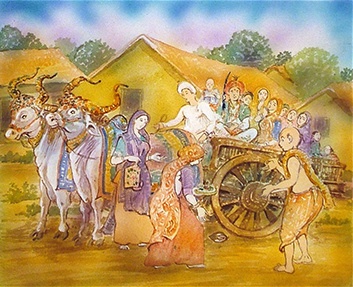
Wedding of Trikamjl to Benbai
For an ordinary individual, marriage entangles a person into maya, but for those blessed it can become a means to salvation. Such was the case for Trikamji.
Marriage brought with it its own responsibilities. Living in a simple but extended family, Trikamji had to toil hard on the fields. In this way, He began to wonder if He was slowly losing His love for the Lord, but unknown to Him the Lord had not forsaken Him. Due to these domestic responsibilities, His true spiritual path was delayed by eight years.
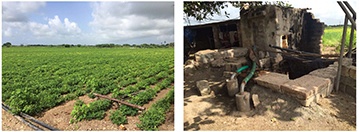
Picture: original plot owned by Haridas Maharaj and possibly where Trikamji Bapu once worked (borders of Kunwardar and Majiwana gaam).
During these eight years Trikamji became the father of a young girl named Sejbai”.
In the course of events, Benbai became expectant of their second child. Undocumented stories indicate that through some domestic upheaval, Trikamji kicked His then expectant wife and as a result both Benbai and the unborn child suffered and eventually passed away (Vikram Savant 1957, 1901 A.D.). Trikamji had remained married for a total of eight years.
Although now released from the bondage of marriage, Trikamji was now charged with the responsibilities of bringing up His young daughter. However, to break free from this bondage of maya seemed virtually impossible.
Note: The Passing away of Benbai mata in 1901 would have made Trikamji Bapu 37 years of age at that time. Considering that He lived a total of 66 years, it can be worked out that Bapu spent approximately 27 years as a yogi, taking into account approximately 2 years spent in Rojhda gaam looking after His daughter.
“Bhabhi’s Curse”
The spiritual road is not without struggle and walking along its path gives rise to fiery tests. On the one side, there were the responsibilities of looking after His young child and on the other the attraction and love for attending kirtans and bhajans. His heart was stolen by hearing the name of the Lord and slowly He would forget His responsibilities and give His young daughter to His Bhabhi (sister-in-law) to look after. Being an extended family and reluctantly taking on this duty, His Bhabhi indicated that if He wanted to attend bhajan kirtans daily, then it would not be possible for her to look after His daughter. On one occasion, it so happened that Trikamji returned late from a satsang. With sarcasm. His Bhabhi said, “Do we have to remain hungry daily until you return home?”
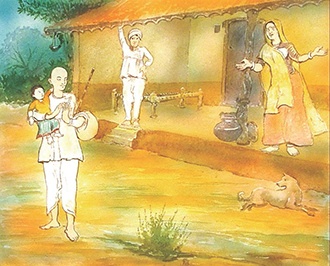
Trikamji leaving kunwadar Gaam
It would have been better if you had left home and become a sadhu. At least you would have got free food and be able to do satsang all day!”
On hearing these harsh words, Trikamji now knew that He could not stay here any longer and along with his daughter He thus decided to leave this household. For Trikamji, the words of His Bhabhi were not a curse, but divine words, which were liberating and helping Him break the chains of “maya” (worldly illusion).
The next morning, binding a small “potli” (pouch) and holding His daughter close, Trikamji announced to His brother that He was leaving. His brother tried to convince Him otherwise, but Trikamji replied:
“No, I will earn by myself and also look after my daughter. I’m going.”
On hearing this, His Bhabhi said: “Let Him go, don’t stop Him. Once He has responsibilities, He will then realise how hard it is. Let Him go, He will return in a few days.”
But, Trikamji did not stay long enough to hear these words and leaving Kunwadar by foot He reached Rojhda Gaam (the town of His in-laws).
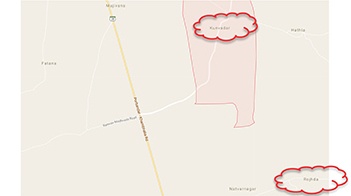
Map showing connection of Kunwadar to Rojhda. Note also positions of Majivana, Fatana, Hathla and Natwar gaams
“Miracle in Rojhda Gaam”
Trikamji stayed in Rojhda gaam for two years working as a helper on the fields. Taking the role of both mother and father He looked after His young daughter. On the one hand, there was work on the fields and on the other the responsibilities of looking after His young child but at night time He sat in satsang, singing bhajans and kirtans as well as contemplating on the Lord.
What the Lord had intended took its course. One eventual day His young daughter passed away (aged 4 years) and the material bondages, which were binding Trikamji were now lifted.
Now all His time was spent toiling the fields or singing bhajans and kirtan. Sometimes He would just sit in a satsang all day and night.
On one occasion, it was Trikamji’s duty to night guard the fields. But that care free soul was so engrossed in His kirtan and bhajans that He became oblivious to where He was-doing satsang or guarding the fields.
Seeing Trikamji away from the fields one of the workers made a complaint to the landowner that no one was looking after the fields and that Trikamji was sitting, singing bhajans.
Enraged, the landowner went to the fields to check for himself, but found Trikamji attending to His duties. Returning back to the town he was then amazed to see that Trikamji was also deeply engrossed in bhajans and kirtans at the same time.
Not being satisfied, the landowner returned back to the field but found Trikamji there as before. Totally perplexed, he could not figure out which was the real Trikamji – on the field or in the town?
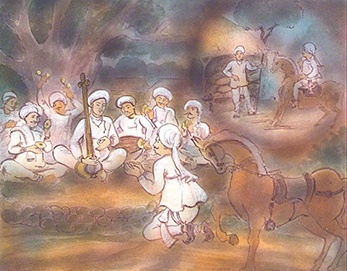
“Bapu I did not recognise Your true nature.”
Rushing back to the main part of the village the landowner fell to the feet of Trikamji and said “Bapu please forgive me. I did not recognise Your true nature”. But, Trikamji oblivious to all this replied, “No, let it go, let it
The following day Trikamji decided to give up everything and take to the spiritual path, thinking to Himself, because of me, the Lord had to suffer by taking my part and acting as me looking after the fields at night whilst I sat and sang bhajans and kirtan.
This was a main turning point in the life of our Bapu and the beginning of next chapter in His story.
“In search of the Guru”
Without Guru there is no “gnan” (knowledge). Thinking in this manner, Trikamji went in search of such an individual and reached the ashram of Paramhans Archarya Shri Nathuram Sharma at Bilkha Gaam, near Junagadh.
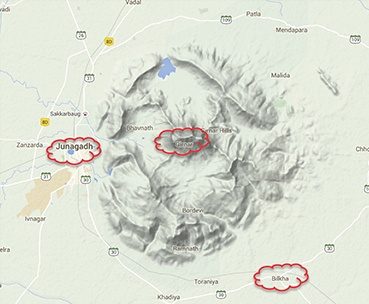
Bilkha Gaam- in Junagadh District (bottom right)
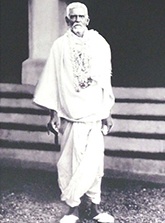
Pujya Sat Guru Shri Nathuram Sharma
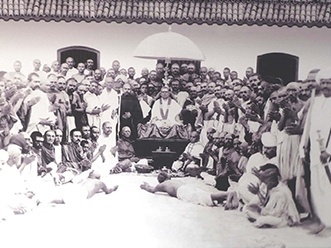
Pujya Gurudev with disciples
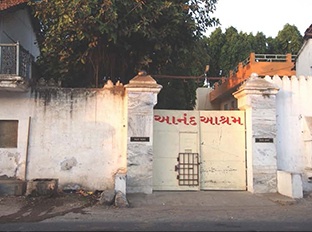
Present day: “Anand Ashram” – Ashram of Shri Nathuram Sharma
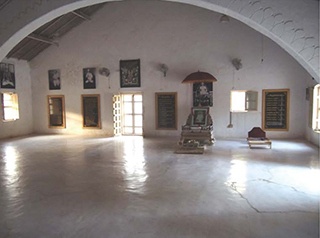
Main Hall, possibly where Bapu once sat
On reaching the ashram a katha was in progress and Trikamji sat quietly until the sermon had finished.
Seeing the new face with dirty clothes, the guru realised that Trikamji was a good soul and proceeded to test Him by questioning:
Guru: “Where do you stay?”
Trikamji replied: “On this earth.”
Guru: “Why have you come?”
Trikamji: “To know the Almighty.”
Guru: “You are young, you have your whole life in front of you. The path of “vairagya” (dispassion) is not easy. It is like walking on the edge of a sword. It is best if you return back to your material life.”
Trikamji: “I have not come to give up and go back.”
Being accepted as a disciple, He lived in the ashram for six months observing its strict rules and practices but He could not escape from His own angry nature. He could not tolerate injustices and His eyes would turn red in seeing any wrong doing, but during this stay He managed to gain some control over His fiery nature.
There were many wrongs which He had observed, but He always kept in mind that being under the wing and care of the Guru, He should keep His anger in check and maintain His discipline and composure.
Accounting of monies within the ashram was strictly controlled. On one occasion an incident occurred when Trikamji was sent to purchase some vegetables and fruits from the local market. On returning there was a discrepancy of about 4 anna (old Indian currency) in change. Becoming furious, the Guru scolded Trikamji in the presence of all those around Him (with an aim to make a disciple diligent in all aspects of life and for him to excel in everything that he undertook).
Standing silent, Trikamji did not move. He accepted the scolding, but could not tolerate that He was insulted in the presence of all those around and with this still in mind, decided that He did not want to remain in the ashram any longer. The following day, labouring from morning, Trikamji earned 4 anna and laid this at the Guru’s feet. The Guru remained silent but always aimed for all his disciple to excel and become complete.
The following morning nobody had seen any signs of Trikamji. On noticing this, the Guru asked one of the disciples to check His quarters, but on searching Trikamji could not be found anywhere. It appears that the Guru wanted to say something to Trikamji, but how could he tell Him, for Trikamji had long departed from the ashram the night before.
“Sadhna at Girnar”
From Bilka, Trikamji walked and reached the Gimnar Hills in Junnagadh district. Girnar was a holy and sacred place where many “sanyasi” lived and Trikamji was firm in faith that He would come across some holy individual to help Him on His spiritual journey.
Walking along a small path He noticed an elderly sadhu with white beard and matted hair sacrificing offerings in a holy fire (“ahuti”). As the sadhu gazed at Trikamji, he enquired: “What has brought you here?”
Trikamji replied: “To find the Almighty and to do “sadhna” (spiritual practices).”
Getting up, the sadhu struck Trikamji on the back, not once or twice but three times and repeated, “Why have you come?”
But, Trikamji had only one reply, “To find the Lord.”
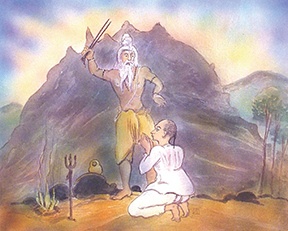
Sadhu at Girnar
The sadhu then hit Trikamji another 4 times, but Trikamji did not utter a word. Seeing His inner strength and boldness, the sadhu threw down his “chipyo” (long metal prong) and embraced Trikamji blessing Him that He would become a great saint and gain knowledge of all the deep spiritual secrets.
Trikamji remained with the sadhu for several months and during this period many other sadhu’s used to visit this place as well as His new found guru.
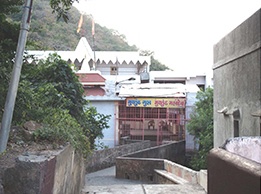
Moochkund Goofa – reconstructed about 40 years ago
Note: It is said that Bapu did His sadhna at “Moochkund Goofa” (Moochkund Cove). This place is mentioned in the Mahabharat and Shrimad Bhagavatam, where through His deceptive ways, Lord Shri Krishna led the evil Raja Kalyavan to where Raja Moochkund lay in deep sleep.
Raja Moochkund hod been given a boom by Lord Indra that he would gom deep sleep and peace following many years of fighting and should anyone disturb him, his goze at the person who woke him up would turn them to ashes. In this way, Lord Krishna led Raja Kalyavan to his death.
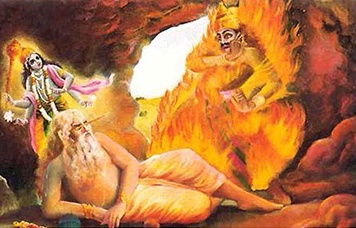
The awakening of Raja Moochkund and burning of the evil Raja Kalyavon
It was common practice for many sadhus to smoke gaanjha (marijuana) and whilst this practice took place, Trikamji would sit isolated away from this gathering. Instead, He remained steadfast in His practice and continued His bhajan, kirtan and spiritual practices.
With time, Trikamji decided that this was not the place for Him and He slowly approached the sadhu to inform him. However, even before uttering a single word, the sadhu said, “Are you desiring to go?”
Trikamji replied confirming His guru’s question – “Yes.”
On hearing this, the sadhu bestowed upon Him great blessings and continued, “… Go, your “sthan” (place) is already waiting for you.” Leaving Girnar, Trikamji travelled by foot and made His way to Ghumli Gaam and Bhrugukund (near Porbandar).
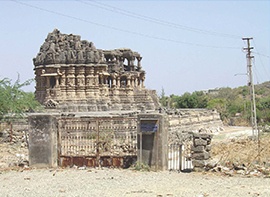
The famous Novlokho Temple at Ghumi I believed to be on andent “Surya” (Sun) temple.
Note: The original Shivling which was situated in this temple was moved to Kedareshwar Mahadev Mandir in the centre of Porbandar.
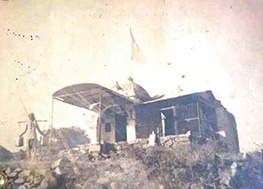
Old picture of Ashapura Mandir at Ghumti (1974)
“Aabhapro Doongar”
At Bhrugukund a resting “Rabari” (name of a clan) saw an angelic looking Trikamji dressed in soiled white clothing. Being inquisitive, he asked Trikamji as to where He was going. Trikamji replied “Aabhapra”.
it being midday and very hot, at the request of the Rabari, Trikamji remained with Him for a few hours. At the behest of this companion, Trikamji was offered fresh milk and told that it would give Him strength in the climb ahead. The Rabari advised Trikamji to return early before nightfall as leopards roamed the hills and no one has been able to stay on “Aabhapro” overnight.
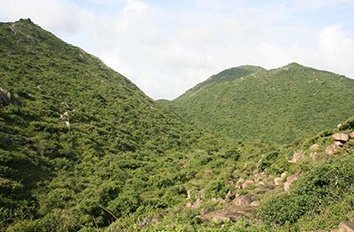
Aabhopro Doongar with Bapu’s Mandir at the top (left)
Trikamji began His climb and upon reaching the top did not come down again for the next seven years.
With His deep meditation and penance, Aabhapro became sacred and the nature of wild beasts like leopards, lions and snakes became placid.
For the first two years during His stay, Trikamji survived mainly on fruits. The next four years by only eating leaves. The last year was survived by consuming only three sips of water daily.
Bapu had once disclosed that one night Aabhapro had come to Him and showed Him its true form. In this vision, the mountain showed Him a cave, which was full of trees, flowers and fruits. He decided that He would remain and continue His austerities here.
Snakes used to wrap around His neck and wild leopards sit beside Him, but Bapu would remain in His trance.
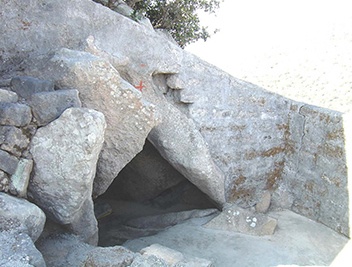
Meditation cave at Aabhapro
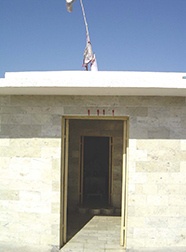
Mandir at Aabhapro
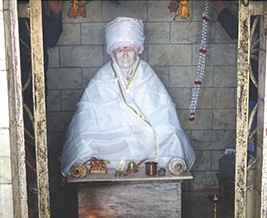
Bapu’s Murti in Mandir at Aabhapro
On one occasion two wealthy individuals along with two Brahmins – Karsanji Raghavji (Hathla Gaam), Mansang Gorasia (Hathla Gaam), Bhagvanji Gorasia (Gadu Gaam), Liladhar Haridas (Kunwadar Gaam – Trikamji Bapu’s brother) went to meet Bapu. On reaching the top they saw Bapu wearing a full studded garland made of precious gems. On asking Bapu how He got this, He replied, “It must have been some Devata (divine being) who put it on me.”
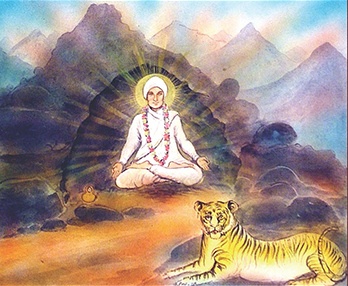
Meditation at Aabhapro
Following seven years of deep austerities, the cave within Aabhapro shone with great luminance and at once divine knowledge was bestowed upon Trikamji gifting Him with the light of knowledge (Gnan Prakash) and of the Absolute.
“Darshan”
Legend has it that at Venu Doongar (the mountain opposite Aabhapro) there lives Naagi Mata (“Naked Yogi”) who although over 800 years old still looks like a child.
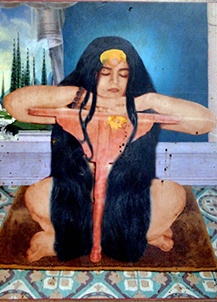
“Devi Naagi Mota”
It is said that whilst doing His daily sadhana, Bapu received the blessings from Nagi Mata, but Bapu being a male and Nagi Mata being a female yogi, this transmission of knowledge was done from a distance, with Nagi Mata remaining on Venu Doongar and Trikamji Bapu doing His spiritual practices on Aabhapro.
“Gnan Prakash”
Note: Although it is said that Trikamji Bapu could not read or write, a hand written book called “Gran Proksh” (Light of Knowledge) had been written by His near serving disciples. Having seen a copy of Jina Bapu’s copy, it appears that this book is really a compilation of notes possibly taken during close instruction or in group meetings by several disciples.
This book is said to contain the life of Bapu, notes on astrology, pranic breathing as well as details of predictions of future events.
The location of the original copy of Gnan Prakash is not fully known although o handwritten copy belonging to Jino Bapu has been obtained and the subsequent and original printed publication of Gnan Prakash has been uploaded as a PDF file on www.trikamjibapu.com site for all readers.
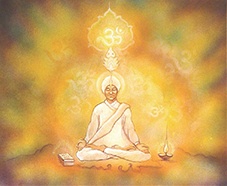
Compilation of Gnan Prakash
In the process of revelation, the Lord first reveals His knowledge to His disciple and then follows this with instructions on elevating the common man. In the case of Bapu, it was elevating the Bardai community to a higher level of social living and understanding.
“Meditation in Dwarka”
Upon descending Aabhapro, and following His visit to Kunwadar and Bawarvav Gaam, Bapu made His way to Dwarka and stayed within a cave know as “Shakshi Gopal ni Goofa” (said to be situated near the “moti ghat”) where He recommenced His meditation.
He remained in Dwarka for a total of two years ending up growing a long beard and becoming unrecognisable. Here, on four occasions He envisaged that He should leave His physical body, but following the requests from devotees (Dayaram and Vithaldas, a Gugari Brahmin) to pass on and spread “Brahm Gnan” (knowledge of the Supreme), He heeded to their call and delayed His physical departure.
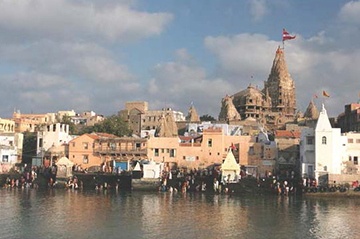
Whilst in Dwarka, He was also visited by a devotee by the name of Joothabhai Modi who requested Bapu to stay with him in his home town of Beraja. Bapu accepted the offer, but said that he would come when the time was right. (See section entitled: “His Parcha” Miracles).
“Natwar Gaam & Bardai Brahmins”
Bapu had observed that our Bardai community was very “backward” and poverty stricken with barely enough food or clothing to meet their daily needs. He noticed that our people worked on the land for others and in return looked at gaining a small share of the crop at the end of the harvest. Through observation and inner knowledge, He concluded that this misfortune was due to the practice of “selling” young daughters as child brides (“Kanya Vikrai”) due to the scarcity of girls born in our Bardai community
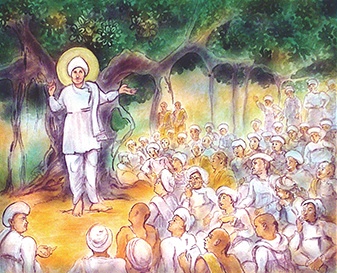
Pujya Bapu giving His serman at Natwar gaam
Parents would rejoice on hearing of the birth of a baby girl, seeing the new daughter child as a future means to gain money.
Bapu proclaimed that accepting and taking money on marrying a daughter was even a greater sin than slaughtering meat. Butchers killed and took the meat of other animals, however, parents were “killing and betraying” their own flesh and blood.
On one occasion, a congregation gathered in Natwar gaam and invited Bapu to give them “ashirwad” (blessings). Bapu agreed on the condition that He would only come if the town folk were ready to listen to His instructions. In this, His first sermon, Bapu informed the gathering of the above knowledge and instructed that they should not accept a daughter’s money or any dowry, but to marry her off using “kanku” (vermillion powder) and “ghatdi” (chundadi). He then advised all those present to spread this instruction to the neighbouring towns and by observing this advice, all would prosper.
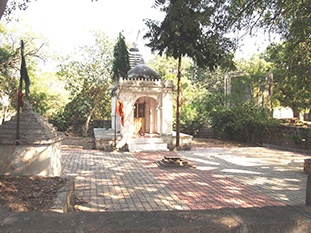
Natwar Gaam – The very place Bapu did His first sermon
Note: When we look closer at Bapu’s request, the great thinking behind His instructions can be understood much more clearly. Not only did it standardise the amounts of money given at a wedding, it also made weddings affordoble, not only for the wealthy, but also for the poor in a way that no parent could ever be left shameless on such a grand occasion.
It is import to appreciate and understand that these suggestions were not merely imposed on the many “Moostan” (councils) of the villages but the elders were consulted and they in turn approved these terms collectively by signing documents to show agreement. The original copy and translation of the minutes of the meeting which took place in Natwar goam con be found on this website. Those who agreed then eventually become known os the present day “Noni Noth” (small community and known as Bardai Brahmins) and those that continued in their old way were then known as the “Moti Noth” (large community).
This example demonstrates that not only was Bapu a great spiritual yogi, He was also a great social reformer.
Two other places, where details of the formation of what is our present day Bardai Samaj are noted below for historical purposes.
Majivana Gaam
It is said that in Majivana gaam, Bapu pulled a string in a field to divide it into two parts and then asked those that agreed with His instructions to move to one side and those that did not, to move to the other. In this manner, a stronger Bardai identity began to form in these small towns and villages. This led to the eventual creation of our Bardai community, as we know it today.
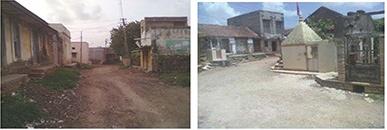
Present day Majivana Gaam
Fatana Gaam
In Fatana Gaam, Bapu stayed at the house of Vejhajibhai Nagaji Odedra (Maher) and calling the Bardai Samaj Maastan (council) leaders of the town, held a meeting here where He similarly departed His instructions to the town folk.
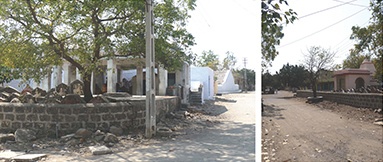
Present Day Fatana Gaam
“His Parcha” (Miracles)
Bapu Ni Vaav
There are two separate stories associated with the current ashram known as “Bapu ni Vav”.
The first relates to Jam Sahib and the donation of the land on which the ashram was built and the second, on how the area got its name.
Both the stories relating to this are detailed below.
The rains were heavy and the winds were high in the area of Fuljhar Ness.
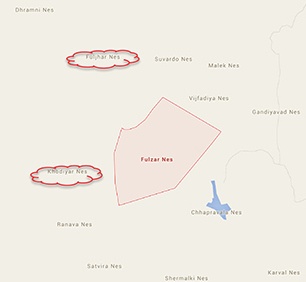
Relation of Fuljhar Ness to surrounding towns.
Searching earnestly for Bapu, Bhagat Nago Garsar (a Rabari of Khodiyar Ness) saw Bapu sitting in deep mediation on a large bolder.
Unmindful to all that was happening around Him, the waters had risen to waist height, but Bapu remained still in His tranquil meditation.
Finally, arousing Bapu from His deep state, Bhagat Nago brought Bapu back to his house and made a request to Bapu that he would like to build an “aasan” (seat / dwelling) for Him. Gaining Bapu’s permission, Bhagat Nago went off to collect some bamboo from the nearby forest but in the process, was arrested by the forest soldiers on grounds of his trespass and for cutting forest wood without permission. The soldiers subsequently reported this incident to Jam Sahib, the local ruler of the Kingdom.

Jam Sahib Ranjitsinhji Vibhaji II (10 September 1872 – 2 April 1933)
Note: Jam Sahib is the title of the ruling prince of Nawanagar, now known as Jamnagar, Gujarat. The Jam Sahibs were from the Jam Jadeja clan, who are a branch of Sommo Rajput. The name of Jamnagar was derived from the same root, while the word “Jam” itself means “King”, “Sahib” is on Arabic term which literally translates to “Owner” or “Proprietor”.
Ranjitsinhji often known as Ranji, was the ruler of the Indian princely state of Nawanagar from 1907 to 1933, as Mahoraja Jam Sahib, and a noted Test cricketer who played for the English cricket team. He also played first class cricket for Cambridge University, and county cricket for Sussex and is widely regarded as one of the greatest batsmen of all time.
No matter how great a cricketer he was, Bapu never gave him His darshan!
In the meantime, a devotee by the name of Jethabhai Soni (from Bhanvad) reached Khodiyar Ness, having also braved the poor weather.
Upon seeing Bapu, the devotee fell to His feet and said, “Bapu, with all this bad weather, how are you able to stay here?
Laughingly, Bapu replied, “It is all of you, who are engaged in material life spoil us sadhu’s! It is better if you rather chant the holly name of Omkar Vishveshwar (Lord Shiva). By reciting the Lord’s name, neither grief nor fear can ever trouble you. However high you want to reach on the path of Bhakti (devotion) make sure you make its foundation equally deep. All the wealth that you have amassed can one day be washed away, but all the Dharmic (righteous) deeds which you have done will always remain with you and can never be taken by anyone. At the final stage, it will give you peace and salvation.”
Still unsatisfied, Jethabhai Soni continued His request for Bapu to come with him and so saying, “… Let it be Hari’s (Lord’s) will.” Bapu submitted to His devotees wishes and went to Bhanvad.
Whilst in Bhanvad gaam, the son of Nago Garsar came running to Bapu
and advised Him that Jam Sahib had fined his father a hefty amount as a punishment for cutting the bamboo in his forest. In an effort to pay this large fine, Nago Garsar had to sell all his cattle and livelihood. Enraged at this treatment of a poor devotee, Bapu said to the son, “Don’t worry, Jam Sahib will return all the money and everything will be fine.” So saying, Bapu left Bhanvad and went to Gondal. Here He stayed at the house of the Kumbhar family.
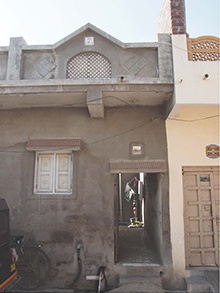
The house in Gondal where Bapu stayed (2015)
Knowing that what had happened was not an auspicious act; those close to Jam Sahib explained that he should go to Kileshwar and return the large fine back to the poor Rabari.
In the process of this heartfelt misdeed, Jam Sahib also donated the land approximately 2 miles from Kileshwar so that an ashram could be built for Bapu. This place is now famously known as “Bapu ni Vay” (Bapu’s well).
Jam Sahib now had a deep and burning desire to gain Bapu’s darshan.
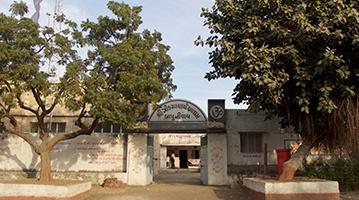
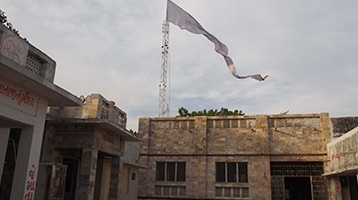
Mandir at Bapu ni Vav
Two miles from Kileshwar is a doongar (mountain) by the name of Dantala Shikhar which has a cave and is said to be Bapu’s favourite place for mediation. This location is also known as “Ambli Vadi Goofa”.
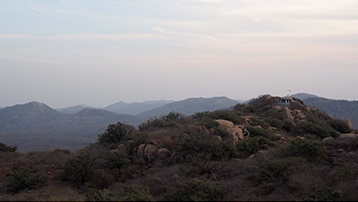
Ambli Vadi Goofa – Mandir is on the hill on the right side (2015)
One day, Bapu was on Venu Doongar travelling towards Son Kansari (just below Aabhapro) when He met one forest guard on the way.
Never having met him before, Bapu said, “You must be juma of Mokhana gaam?” (a man of Sindhi descent and Muslim by faith). On hearing this, Jumo fell at Bapu’s feet for His blessings but Bapu laughingly said, “Jumo, you bowing to me does not seem correct. It is better if you bow to the Almighty instead. We are just His, devotees and you bowing to me makes me (a devotee of the Lord) incur sin.”
But Jumo replied, “You are a divine being and all we want from you is your “doowa” (Islamic word meaning invocation, but here translated as blessing).”
Bapu continued to ask, “Juma, how are your wife and children, are they all well?”
Jumo replied, “Bapu they are all good. With your blessings and those of “sai oliya” (Islamic word for Saintly persons) we are all living happily.”
Jumo continued. “Bapu, there has been instruction to Devubha (Jam Sahib’s brother) from Jam Sahib himself, that he wants to gain your darshan.”
Laughingly, Bapu replied, “Juma, i am just an ordinary person, I have no qualities. I do not see it fit that a ruler of such a large place comes and bows to me.”
By the time the conversation was coming to an end, approximately 10 soldiers had arrived with Devubha who with folded hands addressed Bapu, “Bapu, it is Jam Sahibs order that we honourably escort you back to Kileshwar”.
Jam Sahib very much wanted to gain Bapu’s darshan but Bapu had always denied him a meeting (for his arrogance as well as ill-treating His devotee). This was the only method which Jam Sahib knew in which he could gain an audience with pujya Bapu.
Upon reaching Kileshwar and so that He could not escape, Trikamji Bapu was locked in the small windowless Mahadev Temple. Bapu was held for a total of five days, with soldiers guarding the place at all times. Following this imprisonment, Devubha rushed to Jamnagar and brought back with him an anxious Jam Sahib who was now preparing to have his audience with Trikamji Bapu.
Thinking that this was now his opportunity, he entered the temple grounds and moved towards mandir, but on flinging the temple doors open, there was no one in sight! Bapu had miraculously vanished!
All that was there in the windowless temple was a tiger skin assan and the sweet smell of burning incense in the air.
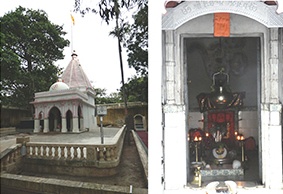
Kileshwar Mahadev Mandir
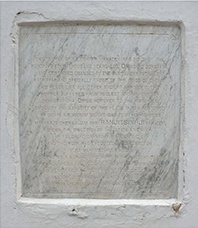
A historical inscription at Kileshwar Mahadev mandir reads:
THE TEMPLE OF KILESWAR MAHADEV WAS BUILT BY THE PANDAYVA’S 4000 YEARS AGO. OWING TO CONSTANT AND CONTINUED CHANGES IN THE RULING DYNASTIES OF KATHAWAR AND SPECIALLY THOSE OF THE KINGS OF GHUMLI. THIS PLACE ALL OTHER ANCIENT SHRINES IN THE PROVINCE SUFFERED FROM NEGLECT AND MAHOMEDAN DEPREDATIONS. OWING HOWEVER TO THE HISTORICAL ANTIQUITY AND SANCTITY OF THE PLACE IT WAS RESTORED IN 1913 – 1914 A.D VIKRAM SAVANT 1969 – 1970 BY HIS HIGHNESS MAHARAJA DHERAJ JAM SHRI RANJITSINGHJI BAHADUR
UNDER THE DIRECTION OF THE STATE ENGINEER MR FULCHAND DAMYBHAJ PAREKH AND THE WORK WAS EXECUTED BY CONTRACTOR VORA MAHAMMAD AMUI MODI
THIS DENOTES A STRONG LANDMARK IN THE HISTORY OF THE PROVINCE UNDER THE AEGIS OF THE BRITISH CROWN WHICH HAS ENABLED A RAJPUT RULER TO SUCCESSFULLY RESTORE A SHIVA TEMPLE WITH THE AID OF A VAISHNAV ENGINEER AND A MAHOMEDAN CONTRACTOR
In this act, Bapu wanted to give a lesson to Jam Sahib and show him that it was wrong to harass his own people, especially the poor and needy!
It should be noted that Jam Sahib Ranjitsinhji never managed to receive Bapu’s darshan.
This story is well known among the local population, especially in the direction of Hallar, Sorath, Okha and Baradi areas.
Whilst on His travels with devotees on a bullock and cart, Bapu saw a Rabari chasing after his herd that were rushing towards the gaam of Bhanvad (approximately two miles away). On enquiry, it emerged that although well fed, the herd had no drinking water locally and were hurriedly running towards Bhanvad where they could quench their thirst. On hearing this, Bapu halted His travels and immediately decided to start His sadhna and meditation at this location. He remained and meditated here for several days before establishing the Vay (well) which at that time was “30 hands deep”. The well, although now deeper, still provides water for the cattle as well as cultivating the land.
Note: The area “Bapu ni Vav” (“Bapu’s Well”) is named after the well which was established by Trikamji Bapu (on the site originally donated by Jam Sahib) for the sake of providing water to grozing cattle and herd.
The murti estoblished at “Bapu ni Vov” was originally destined for Bapu’s doson at the top of Abhapro Doongor. Whilst reaching here, it become clear that it was too heavy for it to be carried to the top of Aabhapro and 50 was inaugurated at Bapu ni Vav in 1969 AD.
Bapu ni Vav became a registered trust in 1979 and was set up by Shri Bhagwanjibhai Bhimji Joshi.
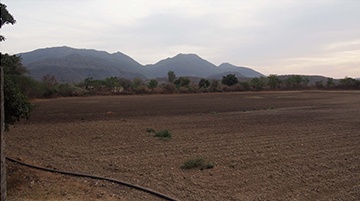
Land behind the “Vaav” – currently cultivated for feeding the cows

“Vaov” (well) – Newly reconstructed (2015)
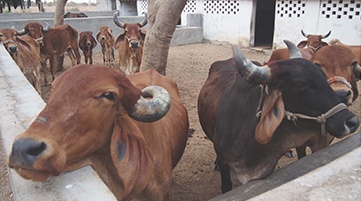
“Gaushalla” (Cow Shelter) at Bapu Ni Vaov
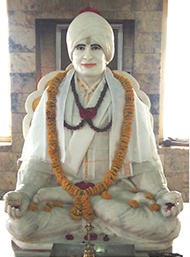
Murti of Bapu at “Bapu Ni Vav”
Beraja Gaam
A similar incident took place in the town of Beraja (also known as Barej) at the house of Joothabhai Modi.
Bapu had met Joothabhai previously in Dwarka, but when Bapu came to Beraja at the household of Joothabhai, he could not recognise Him, as Bapu was now clean-shaven and away from His spiritual austerities. When Bapu arrived at Beraja, He shouted, “Hello Jootha, I am here! Do you not recognise me? It is me, Trikamji!”
Realising that this great yogi had come to his house, Joothabhai prostrated at His feet and welcomed Bapu lovingly.
A well-known and repeated incident occurred at the house of Joothabha during the festival of Holi. Bapu wished to celebrate the festival at “Kaanmero” (Kaan is the mountain opposite Aabhapro and about 60km away), but because Joothabhai had just became the father of a new born son (through the blessings of Trikamji Bapu), he refused Bapu to leave on this auspicious occasion.
Bapu submitted to Joothabhai’s wishes and agreed to remain within His room on the proviso that no one should disturb Him until the following afternoon at 4.00 pm. In agreement Joothabhai locked the door from the outside so that none of His family members could disturb Bapu.
In His mysterious way, Bapu made His way to the festival of Holi at Kaanmero. On His descent, He met a Rabari at “Rani Vav” (a well near Ghumli), who offered Bapu to sit on his camel. Bapu refused the request but advised the Rabari to just try and keep up and follow behind Him instead.
The ways of saints and sadhu’s is mysterious and however much he tried, the Rabari could not keep up pace with Bapu. The Rabari along with his camel observed Bapu gradually disappear into the road ahead.
When the Rabari reached the house of Joothabhai, he advised Joothabhai that he had met Bapu who was returning from Kaanmero. Joothabhai responded that this could not be and that all this time Bapu was in his room singing bhajans. On entering the room, they both saw Bapu singing His kirtans and taking prashad from His “pachhedi” (cloth wrapped across shoulder) said, “Here Jootha, have some Holi prashad from Kaanmero.” Joothabhai immediately fell at the feet of Bapu and asked for His forgiveness for trying to keep Bapu restricted to his household.
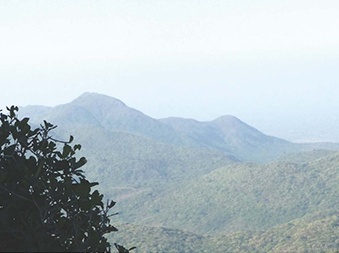
View from Aabhapro. The first mountain is Venu (left) and the far mountain Kaanmero (central-right)
On another occasion, Joothabhai arrived on his ox and cart to fetch Bapu and take Him back to Beraja as his young son was very ill and had a last wish to gain Bapu’s darshan. However, Bapu just reassured Joothabhai, “Nothing will happen to your son, he has still many duties to fulfil!” In saying so, they both left for Beraja. On the way there, their path became obstructed by a small pond. Letting loose the ox to rest and quench their thirst, Bapu also went in, to bathe in the water. As Bapu came out of the water, Joothabhai advised Bapu that a snake had bitten the ox and that they would have to wait some time before he could fetch a replacement. However, Bapu walked over to the ox and talked to the ox saying, “Come on get up, you still have to take us to Beraja!” Straight away the ox got up and they made their way back to Beraja without any hindrance.
This example shows not only the “siddhi’s” (super natural powers), which Bapu had but also demonstrates His kindness and compassion which He showed to every living person and being.
Bhatia Gaam
In the town of Bhatia, the son of Seth Ratan Sinh Dharam Sinh, fell greatly ill and was at deaths door at a time when the rest of the family were attending a function honouring a chief priest at their local mandir (temple). When the family had returned from the function, they found the son had passed away. As all were crying, someone mentioned that Trikamji Bapu was staying nearby and that they should call Him to bless the boy. He would surely bring back the lifeless child.
With high hopes, they all approached Bapu, but He responded by saying that everyone who is born will surely die and that all the karma (actions) of the child in this life had been fulfilled. However, the grieving parents did not accept this and cried, how could they live their life knowing that their one and only child had now gone? With compassion in His heart, Bapu entered the room where the young body lay and commanded, “Son, get up! You have many righteous deeds to perform.” As if rising from a long slumber, the young boy stretched out and got up. In an instant, everyone fell at Bapu’s feet for His kind mercy, but Bapu responded saying, “I am only a simple wondering Brahmin. I do not have any special or mystical powers. This is only due to the compassion of the Almighty Lord. If you want, go and pray at His feet and hail His victory.” In saying SO, Bapu quietly put on His wooden sandals and left the room.
Through these acts of kindness and compassion, whoever came in contact with Bapu, their hearts became filled with faith, love and kindness.
Bhetakdi Gaam
A farmer in the town of Bhetakdi once heard that Bapu was staying in Majiwana. On reaching there he found out that Bapu had moved to the town of Sodhana. Making his way to Sodhana, he then learnt that Bapu had left and moved on again.
With a desire to meet Bapu, the farmer, totally exhausted, finally caught up with Bapu in a small village. On seeing the man drained and tired, Bapu invited him to partake in eating some “rotla” (a traditional grain bread), but the farmer replied that he was not hungry. In reply, Bapu said, “How could you be hungry? Your mind and heart is set on the lunch you have tied to the branches of a ‘Vadla” tree.” On hearing this, the farmer fell to the feet of Bapu, knowing that he had made a mistake in lying to such a great saint.
In this manner, Bapu demonstrated that he was able to read the hearts and minds of people even if they were not verbally expressed,
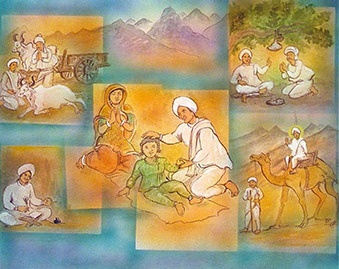
Miracles of Trikamji Bapu
“Adityana Gaam & His Departure”
The last “gaam” (town) Bapu stayed in was Adityana, in the home of Karsanji Dhanji Pandit. It so happened that whilst attending a social function, Bapu overhead someone say, “… And what is He doing here? We do not need the presence of His like at functions like this.”
On returning to the place of His stay, Bapu said, “I now know that I am no longer needed on this Earth and it is now time for me to leave this body. Get ready and make preparations.”
Stunned devotees begged Bapu to rethink, but He was insistent and in time they realised that there was no way they could change His mind.
In trying to delay His departure, one devotee by the name of Ramji Hirji Joshi said, “Bapu, how can we gather all the wood and ghee for the cremation ceremony? Also, many devotees live far away, please give us a chance to call them so as to give them an opportunity to have your last darshan (auspicious sight of a deity or a holy person), otherwise they will never forgive us.”
In reply, Bapu agreed to delay His departure and announced that since it was Shivratri in a few days’ time, He would give up His physical form on this holy day.
In the meantime, a devotee by the name of Jethalal Trikamji Pandit was sent to Porbandar to get “chandan” (sandal wood) and ghee for the last rights.
Within days, approximately 50-60 devotees form Porbandar and nearby gaams came to pay Bapu their final respects as well as do their “pranams” (reverence) to this great yogi. Accompanied with musical instruments, those gathered started singing bhajans and kirtans in preparation for the inevitable event.
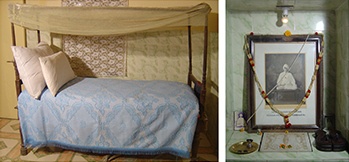
(Left) The original bed Bapu used to sleep in
(Right) Small mondir in room
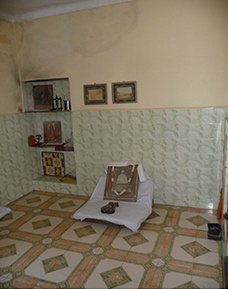
Room where Bapu left His Physical body
As the time approached twelve midnight, Bapu sat down in Padmasana” (Lotus yogic position) and using His control of breath and yogic powers drew His very last breath before slowly releasing. The immortal “atma” (soul) of this great yogi left His physical body and once again merged with that of the Infinite and Supreme Lord.
It was Vikram Savant, Mahavad Teras (Shivratri) 1986, (Monday 26th February 1930 A.D.).

“Miracles After His Departure”
Miracles of great saints are not limited to the physical body and in this respect, many claim to have had Bapu’s darshan and blessings even after His disappearance. There are numerous stories documented as well as spoken about of devotees seeing His miracles – too many to dismiss just as folk tale!
One such story relates to the final incident that occurred during the cremation ceremony.
Whilst announcing His physical demise, Trikamji Bapu had given strict instructions to His close devotees that no one was to physically light His cremation pyre. At that time, some were perplexed and did not fully comprehend His instructions worrying on how the pyre could then take to flame and consume the body.
With the wood laden and ghee smeared over His divine, but lifeless body it is said that the body automatically alit from His right toe without any external torch or flame!
Coupled with this (at the time of His cremation), is a story of a devotee who was at a distance away in another town and saw Bapu with an injury to His right foot. Asked as to what had happened, Bapu replied, “Don’t worry, my toe got burnt in a little fire”.
Note: The “Antim Sanskar (final rights) ceremony as per Hindu tradition, is completed when the body is set alight, starting at the right toe.
In the traditional cremation ceremony for Bardai Brahmins, the corpse is tied to only one central piece of wood and taken to the cremation ground where it is then placed on an arranged pyre of wood which is finally ignited.
The eldest son, or leading mole family member commonly corries out this final act of lighting the pyre.

Samadhi Mandir, Adityana

Pujya Trikamji Bapu’s Murti – Samadhi Mandir, Adityana
“Closing Message”
Bapu instructed that there was no great a guru as one’s own self experience. In life, a Guru is necessary, but if a Sad Guru (“Guru of Truth”) cannot be found then one should learn and progress from one’s own experiences. Once you have experienced the presence of the Almighty Lord in your heart, then the need for a Guru no longer exists. To reach this state, it is necessary to make the heart clean and pure and lose all desires for worldly and material objects. Automatically, the mind will become pure and seeking knowledge from an external source will become unnecessary.
Blessed are those who served Him and blessed is the devotee who worships Him. Blessed is this very Bardai community into which the Almighty gave Him His birth and blessed is the future generation who remembers Pujya Shri Trikamji Bapu with reverence and devotion.
So long as the true ways of Bardai Brahmins continues, so long as our community upholds its traditions and values and so long as we remember His name, Pujya Sant Shri Trikamji Bapu will always shower us with His grace and blessings. There is no doubt about this!
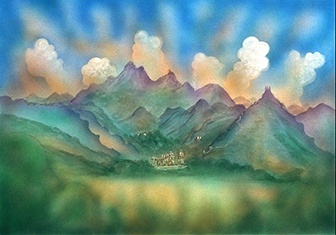
“Akhil Brahmond Adhipoti Satguru Shiromani, Sant Shri Trikmacharya Maharaj ni jai”
OM! OM! OM!
OM Shri Parmatmane Namaha
OM Shri Ganeshshay Namah
OM Vakratunda Mahakaya Suryakoti Samaprabha Nirvighnam Kuru Me Deva Sarva-Kadryeshu Sarvada
OM Shri Sat Guru Dev Namah
OM Guru Brahma, Guru Vishnu, Guru Devo Maheshwara Guru Sakshat Parabrahma, Tsmai Shri Guruve Namaha
OM Shri Shri Radha Shyamsundar Namah
OM Vasudeva-Sutam Devam Kamsa-Canura-Mardanam
Devaki-Paramanandan Krsnam Vande Jagadgurum
Copyrights
All content in this book remains copyrighted and all rights are reserved by the author and Material in this publication may be freely used, only for non-commercial, non-profit, educational purposes and without written permission from the author, provided credit is given to the author and the website www.trikamjibapu.com
In distribution, the authors kindly request that this book is kept in its entirety and distributed as a complete work.